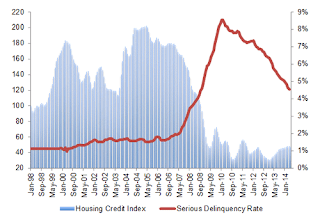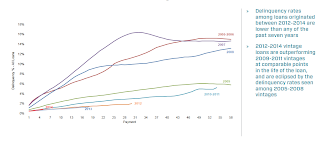by Calculated Risk on 10/20/2014 11:04:00 AM
Monday, October 20, 2014
Is Mortgage Credit too Tight?
I frequently hear stories from prime borrowers about their horrible experiences getting mortgages right now. Yes, the process is difficult because of all the extra checks because the lenders are afraid the loans will be put back to them in a few years.
At the same time, loan officers are telling me it is easy for prime borrowers to get a loan.
This isn't a contradiction - an onerous process isn't "tight credit", it is just risk management. But that is for prime borrowers.
First, here is a piece today from Mark Fleming, chief economist at CoreLogic, writes: Is Credit Too Tight, Too Loose or Just Right?
One of the most pressing issues in housing finance today is the availability of credit. The lack of access to credit has been cited as a reason for the slower-than-hoped-for growth in home sales. The often cited Federal Reserve Loan Officer Survey tells us whether lenders are tightening or loosening credit, but tells us much less about the overall level of availability of credit. Furthermore, terms like tight credit or loose credit imply a normative goal of the right amount of credit. In fact, when discussing this topic, one can’t help but think of Goldilocks and the Three Bears: one bed is too hard, another too soft, and the last one is just right.
In order to determine whether credit is too tight, too loose, or just right CoreLogic has developed the Housing Credit Index (HCI) that measures the range and variation of residential mortgage credit over time and multiple housing credit underwriting attributes. The index includes attributes that are relevant to the assessment of credit risk for a borrower applying for credit. ...

So is credit currently too loose, too tight or just right? In Figure 1, the HCI is shown from 1998 to early 2014 measured on the left axis along with the overall serious delinquency rate measured on the right axis. In the refinance boom of the early aughts, credit availability expanded significantly and then declined, but to a level moderately elevated compared to before the refinance boom. The result of increased credit availability was a modest rise from about 1 percent to 1.25 percent in the overall serious delinquency rate. The mid-aughts saw the significant expansion of credit to double the normal level and the very quick and dramatic contraction with which we are all far too familiar. Credit availability reached its tightest point in late 2010 at only one-third the normal level of the late 1990s. It is safe to say that credit was too tight. Of course, this was a natural response to the quickly rising serious delinquency rate that turned upward dramatically starting in 2006. Since 2010 credit availability has eased in fits and starts with the utilization of modification and refinance programs aimed at struggling homeowners. Most recently, the index is indicating a slight easing, but remains tight by historic standards.According to the CoreLogic index, credit is easing a little, but remains tight.
emphasis added
Below are some other measures. Note: Some less qualified borrowers are using FHA, but that involves high fees (high G-Fees), and the share of FHA loans is at the lowest level in 5 years according to Campbell/Inside Mortgage Finance HousingPulse. But most less qualified borrowers just can't qualify now. Two indicators of this are:
 This graph from Black Knight's mortgage monitor shows the share of purchase and refinance originations with credit scores at or above 720.
This graph from Black Knight's mortgage monitor shows the share of purchase and refinance originations with credit scores at or above 720.As Black Knight notes: "The share of purchase originations with high borrower credit scores is at an all time high". This suggests credit is tight for less qualified borrowers.
 The second graph, also from Black Knight's mortgage monitor, shows that the recent loans are performing very well.
The second graph, also from Black Knight's mortgage monitor, shows that the recent loans are performing very well.This graph only includes loans originated in 2005 through 2014, but older data shows the recent loans are the best performing ever. The loan performance suggests lending is currently tight (I believe this is better loan performance than even during the 2001 through 2005 period when house prices were rising quickly).


